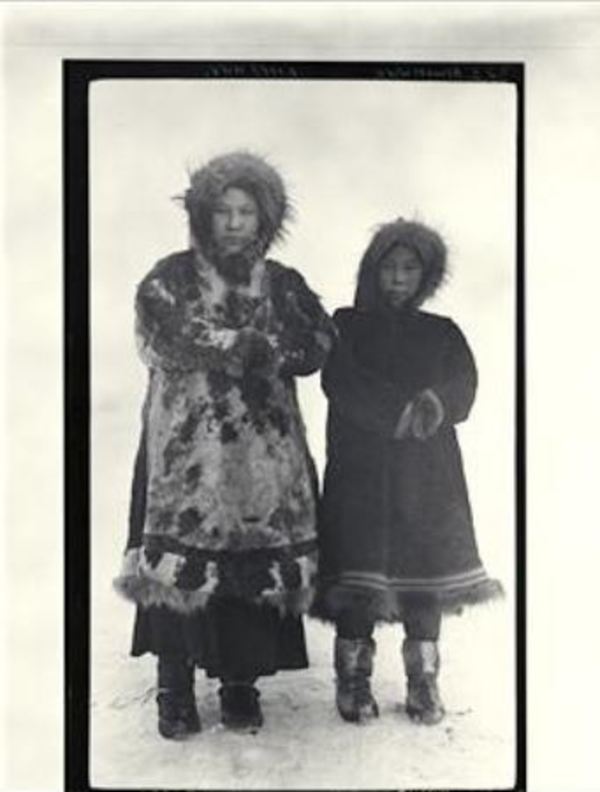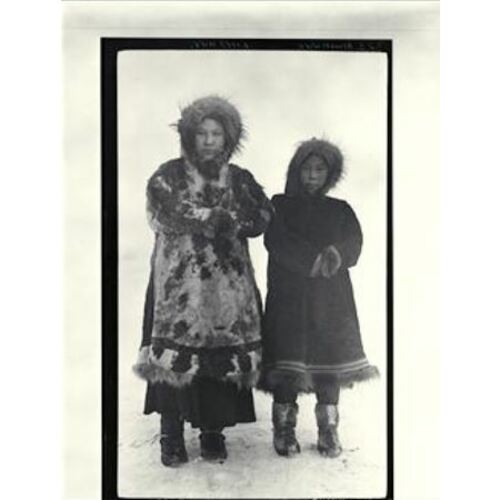
Source: Link
Uttaktuak (Uktuktowik, Iktuktorvik), also known as Sarah or Nellie, Copper Inuit (Inuinnait) seamstress and artist; b. about 1890, probably in the Baillie Islands area off the north coast of Cape Bathurst, N.W.T., daughter of Gunnana and Nivikanna; m. Peter Lopez (Lopes), and they had two daughters and a son, of whom one daughter survived to adulthood; d. August 1932 at Tom Cod Bay, N.W.T.
Most of what is known about Uttaktuak and her family stems from her involvement in the Canadian Arctic Expedition (CAE), a project undertaken between 1913 and 1918. The expedition had two main goals: to explore unknown territory north of the Arctic mainland and to conduct research on the people, wildlife, and environment of the Canadian Arctic mainland coast. To the members of the CAE, the Inuit were not only subjects of ethnological interest [see Qanajuq], but also valuable partners whose knowledge and expertise proved essential to the expedition’s safety and success. Uttaktuak was one of the CAE’s “local assistants,” and she is mentioned in the diaries and books written by several expedition members.
These sources reveal very little about Uttaktuak’s youth or marriage to Peter Lopez, a whaler from the Cape Verde Islands whose ship was wrecked near Cape Parry, N.W.T., in 1906. Most of the crew left the Arctic, but Lopez stayed and became a trapper and hunter. In September 1914 the leader of the CAE’s Southern Party, zoologist Rudolph Martin Anderson*, recorded that the whaler Rosie H. had left the Baillie Islands “manned by Tom Emmsley, Jim Fiji, and Peter Lopez (Portuguese negro),” who intended to winter at Booth Island. In 1915, when Peter was in charge of the ship, Anderson wrote that “Lopez’s wife” – Uttaktuak – was on board, which indicates that they were probably married by then.
George Hubert Wilkins, a photographer with the expedition, noted that the couple joined the CAE in mid August 1915: “Pete Lopes, a Portuguese from the Rosie H., had asked me for a job yesterday, and from what I can hear he seems a willing and capable man, so I engaged him this morning to help with the Star.… He has an Eskimo woman with him, and she will be an additional help with the sewing.” Uttaktuak and Peter travelled with Wilkins on the motor schooner North Star to Banks Island and spent the fall and early winter of 1915 there, at the CAE camp east of Cape Kellet. During their stay Wilkins discovered that Uttaktuak was an accomplished artist: “Sunday, December 5th, 1915. I have given Uktuktowik, Pete’s wife, a book and some coloured pencils. She is extraordinarily fond of drawing, and I would like to keep the book as a record of her art.… I gave her a photograph of a dog to copy. She seems to have a fairly good anatomical knowledge, or is it judgment or instinct? Questioned in detail she says she does not reason out the proportions, she just draws them.” Unfortunately, her drawings do not appear to have survived.
In 1916 Lopez and Uttaktuak travelled north to Peddie Point on Melville Island with the CAE’s Northern Party, led by Vilhjalmur Stefansson*. Lopez hunted caribou and muskoxen, while Uttaktuak skinned the animals, dried the meat, and made winter clothes for the men who would be sledging farther north in search of unknown islands. Stefansson recorded his pleasure at the work she accomplished: “We arrived at [Storker Teodor] Storkerson’s base camp October 16th, which we found very homelike under the management of Mrs. [Elvina] Storkerson and Mrs. Lopez. During the summer they had done their full share in helping dry meat and now they were busy making warm winter clothing and waterproof summer boots without which our work would be difficult and comfort impossible.”
During the winter of 1916–17 Stefansson recorded details of Uttaktuak’s family history. “She was exceptionally intelligent, and well-informed and lucid about how things had been in her youth,” he noted. “She was a good informant and told much about the folklore and practices of her people.” Uttaktuak’s paternal grandparents, Kannraranna and Kotukkaq, were both from east of Langton Bay. On her maternal side her grandmother was Siksorina, and she had two grandfathers: Qiviyunna, the “chief husband,” and Aqonaq, the “junior.” Uttaktuak’s mother was Gunnana, and her father, Nivikanna, was descended from people who lived east of Cape Lyon. They had six children: a girl also named Uttaktuak, who died at about four years of age; a girl named Arnaretuaq; Uttaktuak and her twin sister (who also died young); a boy named Qimiqsanna; and a girl named Mamayauq, who would also become a member of the CAE.
When the expedition left the High Arctic in the spring of 1917, Lopez and Uttaktuak travelled south by dog sled from Melville Island to Victoria Island and then west to Cape Bathurst on the schooner Polar Bear. Stefansson noted, “We also put off several of our other men who desired to become trappers there, Pete Lopez, Jim Fiji, and some Eskimos.”
The Hudson’s Bay Company (HBC) journals for the Baillie Island post indicate that Peter and Uttaktuaq lived at Harrowby Bay from at least 1925 to 1928. Their camp was south of the HBC post, on the west side of the Cape Bathurst peninsula, and they visited the post several times a year. One of the deckhands on the HBC supply ship Baychimo, which arrived at the Baillie Island post in July 1925, met Peter and Jim Fiji, and he later described Peter as “old and grey-headed – and far from home.” Sometime between 1928 and 1930 the family moved east to Tom Cod Bay (near present-day Paulatuk). The records of their annual visits, found in the journals of the Letty Harbour HBC post, suggest that this was a time of great hardship for them.
Uttaktuak and Lopez had two daughters and a son; their younger daughter, Lucy, was born at Tom Cod Bay in 1931. The Letty Harbour post’s journal for 12 Sept. 1932 states, “Mr Lopez’s wife died suddenly about a fortnight ago.” In April 1933 a record was entered in the Letty Harbour journal: “P. Lopez down with scurvey.” A party brought the family back to Letty Harbour, but one of the girls “died on the trail” and was buried at the Letty Harbour mission. Peter recovered and worked at Letty Harbour until July.
After Uttaktuak’s death Peter sent their daughter Lucy to the school at Aklavik. Peter stayed at the Aklavik Roman Catholic mission, working for the brothers and priest. Decades later, Lucy remembered that her father “did fishing for their dogs, two teams plus his own and in winter under ice fishing with nets.… He was cutting cordwood summer and winter at the Brothers’ camp.… I only see him when he comes to town.” Lucy was not able to recall much more about him; he died when she was about eight. She had few memories of her mother but eventually became a skilled seamstress like her. Inuvialuit elder Edward Ruben remembered the family as “nice people.”
In 2011 the Canadian Museum of Civilization mounted a major exhibit called “Expedition Arctic 1913–1918.” Each visitor was given an information card (with photograph) about a member of the Canadian Arctic Expedition. One of the featured individuals was Uttaktuak. When the exhibit travelled across the country, many more people stepped into her kamiks, joined the CAE, and learned about both the expedition and the artistic seamstress who had helped to achieve its major goals.
In September 2002 the author interviewed Lucy Lopez Adams, Uttaktuak’s daughter, in Inuvik, N.W.T., and Edward Ruben in Paulatuk. A photograph taken by George Hubert Wilkins on 21 Feb. 1916, “Minnie and Iktuktorvik at ‘North Star’ camp near Cape Prince Alfred, Northwest Territories,” is held by the Canadian Museum of Hist. (Gatineau, Que.), PHOTOSHIST 51100 (digital copy at www.historymuseum.ca/collections/archive/3333433).
AM, HBCA, B.338/a (Baillie Island journals), 1926–35; B.435/a (Letty Harbour journals), 1932–35. Dartmouth College, Rauner Special Coll. Library (Hanover, N.H.), Steffanson mss 62, box 1, folders 9–10 (John Wilkins papers, diaries, 15 Aug. and 5 Dec. 1915). Ohio State Univ., Byrd Polar and Climate Research Centre Arch. Program (Columbus), SPEC.PA. 56-0006 (Sir George Hubert Wilkins papers). D. W. Gillingham, “Through Canada’s Arctic on the S.S. Baychimo,” Vancouver Sunday Province, 6 Dec. 1925, Magazine sect.: 1, 3. D. R. Gray, “The CAE’s human touch,” Canadian Geographic (Ottawa), 133 (2013), no.1: 23; “Northern people, northern knowledge: the story of the Canadian Arctic Expedition, 1913–1918”: www.historymuseum.ca/cmc/exhibitions/hist/cae/indexe.html (consulted 11 May 2023). Nuligak, I, Nuligak, ed. and trans. Maurice Métayer (Toronto, 1966). Vilhjalmur Stefansson, Cancer: disease of civilization? An anthropological and historical study (New York, 1960); The friendly Arctic: the story of five years in polar regions (New York, 1921).
Cite This Article
David R. Gray, “UTTAKTUAK (Uktuktowik, Iktuktorvik) (Sarah, Nellie),” in Dictionary of Canadian Biography, vol. 16, University of Toronto/Université Laval, 2003–, accessed December 12, 2025, https://www.biographi.ca/en/bio/uttaktuak_16E.html.
The citation above shows the format for footnotes and endnotes according to the Chicago manual of style (16th edition). Information to be used in other citation formats:
| Permalink: | https://www.biographi.ca/en/bio/uttaktuak_16E.html |
| Author of Article: | David R. Gray |
| Title of Article: | UTTAKTUAK (Uktuktowik, Iktuktorvik) (Sarah, Nellie) |
| Publication Name: | Dictionary of Canadian Biography, vol. 16 |
| Publisher: | University of Toronto/Université Laval |
| Year of publication: | 2024 |
| Year of revision: | 2024 |
| Access Date: | December 12, 2025 |



